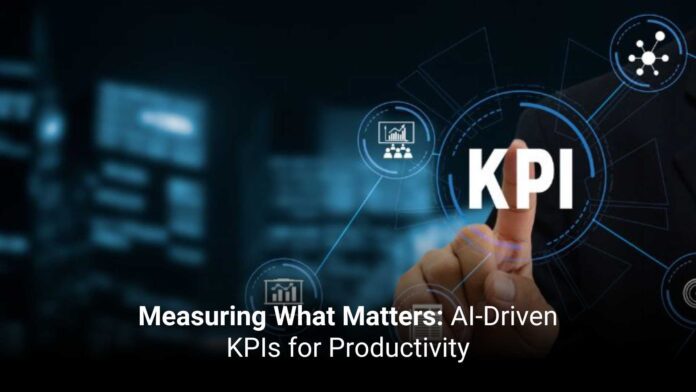A global enterprise has employees across multiple regions. The leadership believes Productivity is firm, but when asked how it’s being measured, the answers are not satisfactory. It leads to misalignment and misses opportunities. Relying on traditional measures of Productivity is no longer enough. Organizations need tools that go beyond metrics, which are AI-driven KPIs.
The importance of AI-driven KPIs lies in their ability to bridge the gap between data overload and clarity, providing a clear understanding of key performance indicators. Businesses today are drowning in data, and leaders risk making decisions on irrelevant information. AI uncovers patterns that ensure you are measuring what truly matters.
This article explores AI-driven KPIs and how they help in measuring Productivity.
How AI-Driven KPIs Measure Productivity
Here’s how AI-driven KPIs help in measuring Productivity.
- Moving Beyond Traditional Metrics
Traditional KPIs rely on data like hours worked, calls made, or projects completed. These indicators fail to capture the drivers of Productivity. AI-driven KPIs analyze multiple data points, identifying patterns and revealing key performance indicators.
- Real-Time Performance Monitoring
AI tools can track workflows and highlight bottlenecks that slow down processes. For example, in a SaaS company, AI-driven KPIs indicate that response times during customer onboarding have a significant impact on retention rates. Based on that, leadership gains visibility into the quality and efficiency of the process.
- Contextualizing Productivity
AI-driven KPIs also measure context. For instance, in a consulting firm, it can evaluate which client deliverables generate the highest revenue impact per consultant hour. It helps identify resources that are aligned with growth.
- Predictive Insights
AI-driven KPIs provide actionable insights. For example, in manufacturing, AI can predict when supply chain delays will affect project timelines and adjust productivity targets accordingly. It prevents disruption rather than losses.
- Personalized Productivity Measurement
AI measures Productivity at multiple levels in an organization. In an IT services company, AI-driven KPIs can highlight how distributed teams collaborate, track project cycle times across geographies, and suggest where automation or training is needed.
- Agility and Continuous Improvement
AI-driven KPIs adjust in real-time as business conditions shift. In logistics, for instance, AI can detect seasonal demand spikes and recalibrate operational KPIs, such as delivery turnaround time, helping leadership maintain quality while scaling.
Benefits of Implementing AI-Driven KPIs in Productivity
Here are the benefits of implementing AI-driven KPIs.
- Alignment Between Strategy and Execution
AI-driven KPIs bridge the gap by translating objectives into measurable indicators. For example, a software company can link its long-term growth goal directly to client onboarding and customer adoption rates.
- Decision-Making with Real-Time Insights
AI-driven systems analyze performance data and update KPIs in real-time. For instance, in a logistics provider, AI can track delivery times, warehouse efficiency, and fleet utilization to alert immediately if service levels dip.
- Identification of High-Value Activities
AI-driven KPIs highlight where value is truly created. In a consulting firm, for example, AI can reveal that certain project types deliver higher ROI, allowing leadership to prioritize those engagements while phasing out low-value work.
- Predictive Capabilities for Future
One of the most significant benefits of AI-driven KPIs is the ability to gain foresight. Instead of relying on historical performance, AI identifies future risks and opportunities. A manufacturing company can utilize AI-driven KPIs to forecast potential supply chain bottlenecks, production slowdowns, or demand surges, thereby gaining the agility to reallocate resources effectively.
- Balancing Efficiency with Quality
AI-driven KPIs move beyond measuring volume to assessing outcomes. For instance, in a marketing agency, instead of only tracking the number of campaigns launched, AI analyzes client engagement rates, conversions, and lifetime value to show whether Productivity is delivering results that matter.
- Improved Employee Engagement and Retention
When employees see that their Productivity is being measured fairly, based on impact rather than activity, engagement rises. In a professional services firm, AI-driven KPIs can highlight the effect of collaboration on success, encouraging teams to focus and reducing burnout.
- Competitive Advantage
Implementing AI-driven KPIs enables companies to operate with clarity and higher impact. By measuring what matters most, organizations stay ahead of competitors, still relying on static performance frameworks.
Key Applications of AI-Driven KPIs
Here are the key applications of AI-driven KPIs.
- Optimizing Workforce Performance
AI-driven KPIs can analyze employee output, collaboration, and engagement to identify patterns in performance. For example, a software development firm can use AI to measure code deployment efficiency, defect rates, and team collaboration metrics. It enables the pinpointing of high-performing teams, identifying training needs, and allocating resources effectively.
- Enhancing Sales Productivity
In B2B, AI-driven KPIs track both activity and outcome. For instance, an AI system can correlate the number of client meetings with deal closure rates, contract size, and sales cycle length. This provides insights into which behaviors truly drive revenue.
- Driving Innovation Initiatives
AI-driven KPIs can track the progress and impact of innovation initiatives. For example, a technology company introducing a new SaaS product can measure project milestones, adoption rates, and revenue contribution, ensuring strategic initiatives stay aligned with business goals.
- Enhancing Remote and Hybrid Work Productivity
With distributed teams becoming the norm, AI-driven KPIs help leaders monitor collaboration, project progress, and individual contributions. In an IT services firm, AI can track task completion, cross-team coordination, and digital engagement metrics, ensuring Productivity remains high.
- Predictive Resource Allocation
AI-driven KPIs enable predictive insights that inform more intelligent resource allocation. In a manufacturing company, AI can forecast demand fluctuations or maintenance requirements. You can adjust staffing, inventory, and project priorities to avoid downtime.
Conclusion
In today’s environment, Productivity isn’t just about output; it’s about impact. Measuring what matters enables you to align teams to priorities and unlock sustainable performance improvements. In sectors ranging from technology and consulting to logistics and manufacturing, AI-driven KPIs have transformed productivity measurement into a strategic tool.
Start integrating AI-driven KPIs into your organization’s performance framework today. Begin by identifying key areas where data can drive impact, and leverage AI to turn insights into action, transforming how your business measures success.
Paramita Patra is a content writer and strategist with over five years of experience in crafting articles, social media, and thought leadership content. Before content, she spent five years across BFSI and marketing agencies, giving her a blend of industry knowledge and audience-centric storytelling.
When she’s not researching market trends , you’ll find her travelling or reading a good book with strong coffee. She believes the best insights often come from stepping out, whether that’s 10,000 kilometers away or between the pages of a novel.







